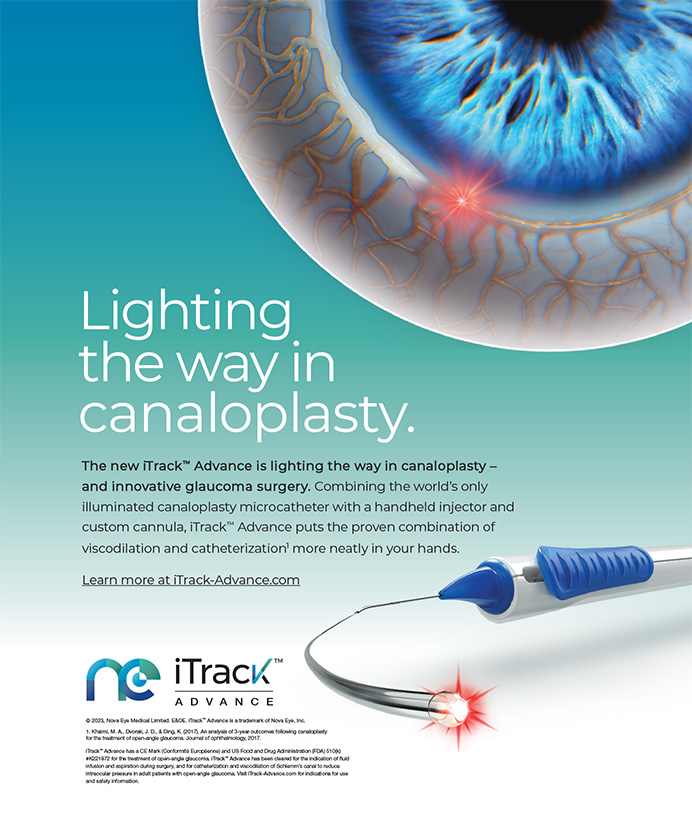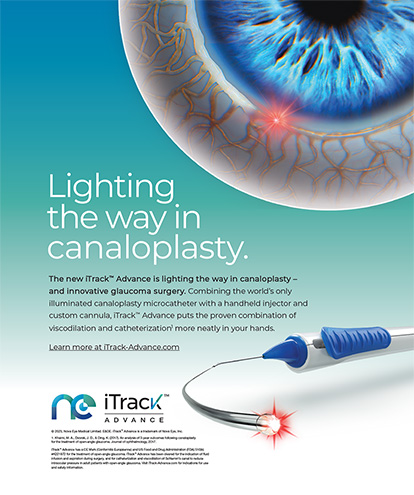HISTORY
A 34-year-old white female, working full time as a stockbroker, was referred to me by a world-renowned glaucoma surgeon. Her history included congenital glaucoma, a phthisical left eye, a nearly mature cataract in the right eye, and a history of multiple previous surgical procedures in the right eye including goniotomies, peripheral iridectomies, filtering surgery in 1990, and a revision of the filtering bleb in 1993 associated with sphincterotomies and multiple peripheral iridectomies.
On examination (Figure 1), visual acuity was finger counting in the right and no light perception in the left. The patient was using her superior nasal peripheral iridotomy as an entrance pupil. There was a relatively thick-walled but functioning filtering bleb in the superior nasal quadrant. IOP was 20 mm Hg without glaucoma medications. The cornea was clear but revealed some peripheral vascularization and endothelial cell polymorphism and polymegatism. The anterior chamber was clear and deep. The iris was highly atrophic throughout its entire periphery with very little in the way of sphincter tissue. The pupil was 3 mm and did not dilate due to 360° of posterior synechiae. There were multiple sphincterotomies in the pupillary margin and a large radial cut at the 12-o'clock position. There was a dense, nearly mature cataract, an absence of zonules visible through the large superior nasal iridectomy, and questionable zonular status in the areas of broad peripheral iridectomies in two other quadrants. Fundoscopic examination was unobtainable, although there was a history of cupping to the periphery.
DIFFERENTIAL DIAGNOSIS AND KEY POINTS
The diagnosis was obvious, but special and unique challenges existed in the surgical approach to this cataract. The status of the bleb was important, and it required protection. The cornea was obviously at risk due to multiple previous surgical procedures and change in the status of endothelial cells. The pupil presented perhaps the largest surgical challenge. Any attempt to manipulate or stretch it could result in tearing of the 6-o'clock radial sphincterotomy out to the periphery with loss of entrance pupillary function. In addition, the atrophic nature of the entire iris was such that any thoughts of surgical repair seemed impossible.
Inadequate zonular integrity added the risk for potential loss of the cataract into the posterior segment. The potential for postoperative inflammation and secondary glaucoma aggravating her underlying disease was also a concern. In addition, preoperative measurements and IOL power calculations were difficult.
TESTS PERFORMED
We were unable to refract the patient. Keratometry measurements showed 7.00 D of astigmatism against the rule. Axial length measured 30 mm, and the horizontal white-to-white measurement was greater than 14 mm. Corneal topography revealed 6.00 D of astigmatism and was different than our keratometry measurements. As a result, we used the central corneal thickness as the basis for IOL power calculation. Endothelial cell count was not done since we had to proceed with surgery regardless of the status of the endothelium. B-scan ultrasonography revealed that the retina was intact.
DIAGNOSIS
Advanced glaucoma, mature cataract, status post multiple glaucoma surgical procedures, functioning filtering bleb, atrophic iris with radial sphincterotomies, compromised zonular apparatus, blind phthisical fellow eye.
MEDICAL MANAGEMENT PRIOR TO SURGERY
Essentially limited to intermittent use of antiglaucomatous medications and massage of the bleb.
SURGICAL MANAGEMENT
A sideport incision was made, and the anterior chamber was partially filled with Viscoat (Alcon Laboratories, Inc., Fort Worth, TX), a dispersive viscoelastic. The cohesive viscoelastic substance, Provisc (Alcon Laboratories, Inc.), was injected directly on the anterior lens capsule, forcing the dispersive Viscoat to the periphery of the anterior chamber to sequester the area of missing zonules and superiorly in a soft-shell under the endothelium as previously described by Stephen Arshinoff, MD, from Montreal. A Fine/Thornton ring was utilized for fixation of the globe. We selected the 16-mm size Fine/Thornton ring, because it had a sufficiently large diameter to avoid traumatizing the bleb.
A temporal clear corneal incision was made utilizing a Rhein 3-D diamond blade (Rhein Medical Inc., Tampa, FL), synechiae were lysed, and a Morcher iris expander ring (Morcher GmbH, Stuttgart, Germany) was inserted utilizing two hooks (Figure 2). This unique device can be inserted by compression into the pupillary space, which it then expands. Flanges on the top and bottom allow it to surround a pupil, much as a tire rim surrounds a tire, and holes in the flanges allow for intraocular manipulation. The expander ring maintained a broad angle of contact with the pupil as it was inserted and allowed stretching of the pupil without concentrating forces on the 12-o'clock radial sphincterotomy, thus avoiding extension of the tear.
Following placement of the iris expander ring, a continuous curvilinear capsulorhexis was performed. A Morcher capsular tension ring was then inserted into the capsular bag utilizing a forceps and a Lester hook. This device expands the equatorial zone of the capsule and transmits any focal force on the capsule to the entire zonular apparatus. Without the capsular tension ring, any focal force on the capsule would be transmitted only to the adjacent zonules, with much greater risk of damage. Thus the ring adds a margin of safety when operating on cataracts in the presence of a compromised zonular apparatus. In addition, it facilitates centration of the bag and IOL postoperatively since the outward force of the ring opposes fibroses of the capsule, unopposed by compromised zonules.
Careful cortical cleaving hydrodissection and hydrodelineation were performed. Choo choo chop and flip phacoemulsification was done. This is a uniquely safe technique for removing nuclear material, because the nucleus is disassembled with mechanical forces in the form of chopping, and the resulting pieces are evacuated largely by high vacuum with low power modulation ultrasound energy. It is an endolenticular technique. Utilizing either a bent Kelman tip or a 30° bevel-down straight tip enables one to approach nuclear material from above, pulling it up to the tip rather than getting underneath to mobilize and evacuate it. Cavitational and ultrasound energy are concentrated at the upper levels of the endolenticular space, remote from the posterior capsule and the corneal endothelium. In addition, the technique allows for fixation of the lens between the two instruments (the chop instrument and the phaco tip) during lollipopping of the nucleus and scoring and chopping. Therefore, no downward force is exerted on the capsule or zonules during lollipopping of the nucleus by the phaco tip.
Phacoemulsification took place with an effective phaco time of 6.4 seconds and an average ultrasonic energy of under 13.7. The cortex, partially held in by the endocapsular tension ring, was carefully irrigated and aspirated. Cortex was stripped tangential to the capsulorhexis rather than centrally in order to help pull it around the endocapsular tension ring. The capsular bag and anterior chamber were refilled with Provisc, after which a bolus of the dispersive Viscoat was placed in the center of the capsulorhexis. A 6.00 D foldable silicone IOL with a 6-mm optic and PMMA loops was injected with the Unfolder (Advanced Medical Optics, Inc., Santa Ana, CA) into the capsular bag without complication.
During removal of residual viscoelastic, vitreous presented through the superior nasal iridectomy. This was removed with a coaxial vitrector with relative ease and without excessive manipulation, after which the iris expander ring was removed utilizing a Lester hook. The remainder of the residual viscoelastic was removed from the anterior segment with a vitrector to avoid vitreous coming to the incision through the zonular defect in the superior nasal iridectomy. Finally, stromal hydration was performed to seal the incision and the paracentesis. The immediate postoperative appearance of the eye is seen in Figure 3.
REHABILITATION AND FOLLOW-UP
The patient was examined twice daily over the next 3 days, prior to being sent to her San Francisco home. Her pressure was controlled with small amounts of antiglaucomatous medicines. She was also treated with Pred Forte (Allergan, Inc., Irvine, CA), Ocuflox (Allergan, Inc.), and Voltaren (Novartis Pharmaceuticals Corporation, East Hanover, NJ) three times daily. Her pressure remained within the teens during the first 2 postoperative days. On the evening of the second postoperative day, tonometry revealed a pressure of 34 mm Hg and some mild corneal edema. Her antiglaucomatous medicines were increased, and the IOP came down to 28 mm Hg the next morning and was 17 mm Hg at the final examination on the afternoon of the third postoperative day.
Her postoperative visual acuity without correction was 20/200 at each postoperative visit during the first 3 days. This was a dramatic improvement in her visual status and was the source of a great deal of excitement on the part of the patient. Subsequently, she has experienced an enormous increase in visual function, although only correctable to 20/80 to 20/100. She uses a word processor at work, grows flowers, and is very aware of colors and the brightness of objects. She continues to lead an active and productive life at this time with a dramatic enhancement in her quality of life. At 2 years postoperatively, her IOP remains in the low teens on no antiglaucomatous medication.
This article and its figures are reprinted with permission from Fine IH. A nearly mature cataract in a patient with glaucoma. In: Ophthalmology Review: a Case Study Approach. Singh K, Smiddy WE, Lee AG, eds. New York, NY: Thieme Medical Publishers; 2002:53-56.
I. Howard Fine, MD, is Clinical Professor of Ophthalmology at Oregon Health & Science University, and he is in private practice with Drs. Fine, Hoffman & Packer, LLC, in Eugene, Oregon. He is a paid consultant to Advanced Medical Optics, Inc., and receives research and travel support from Alcon Laboratories, Inc. Dr. Fine may be reached at (541) 687-2110; hfine@finemd.com.


